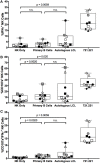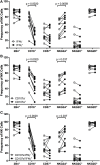NKG2A-Expressing Natural Killer Cells Dominate the Response to Autologous Lymphoblastoid Cells Infected with Epstein-Barr Virus
- PMID: 28018364
- PMCID: PMC5156658
- DOI: 10.3389/fimmu.2016.00607
NKG2A-Expressing Natural Killer Cells Dominate the Response to Autologous Lymphoblastoid Cells Infected with Epstein-Barr Virus
Abstract
Epstein-Barr virus (EBV) is a human γ-herpesvirus that establishes latency and lifelong infection in host B cells while achieving a balance with the host immune response. When the immune system is perturbed through immunosuppression or immunodeficiency, however, these latently infected B cells can give rise to aggressive B cell lymphomas. Natural killer (NK) cells are regarded as critical in the early immune response to viral infection, but their role in controlling expansion of infected B cells is not understood. Here, we report that NK cells from healthy human donors display increased killing of autologous B lymphoblastoid cell lines (LCLs) harboring latent EBV compared to primary B cells. Coculture of NK cells with autologous EBV+ LCL identifies an NK cell population that produces IFNγ and mobilizes the cytotoxic granule protein CD107a. Multi-parameter flow cytometry and Boolean analysis reveal that these functional cells are enriched for expression of the NK cell receptor NKG2A. Further, NKG2A+ NK cells more efficiently lyse autologous LCL than do NKG2A- NK cells. More specifically, NKG2A+2B4+CD16-CD57-NKG2C-NKG2D+ cells constitute the predominant NK cell population that responds to latently infected autologous EBV+ B cells. Thus, a subset of NK cells is enhanced for the ability to recognize and eliminate autologous, EBV-infected transformed cells, laying the groundwork for harnessing this subset for therapeutic use in EBV+ malignancies.
Keywords: B cells; Epstein–Barr virus; NK cells; NKG2A; lymphoblastoid cell lines.
Figures







Similar articles
-
Entry into the lytic cycle exposes EBV-infected cells to NK cell killing via upregulation of the MICB ligand for NKG2D and activation of the CD56bright and NKG2A+KIR+CD56dim subsets.Front Immunol. 2024 Nov 29;15:1467304. doi: 10.3389/fimmu.2024.1467304. eCollection 2024. Front Immunol. 2024. PMID: 39676862 Free PMC article.
-
Impaired cytotoxic T lymphocyte response to Epstein-Barr virus-infected NK cells in patients with severe chronic active EBV infection.J Med Virol. 2001 Jun;64(2):141-8. doi: 10.1002/jmv.1029. J Med Virol. 2001. PMID: 11360246
-
Inhibitory NKG2A+ and absent activating NKG2C+ NK cell responses are associated with the development of EBV+ lymphomas.Front Immunol. 2023 Jun 22;14:1183788. doi: 10.3389/fimmu.2023.1183788. eCollection 2023. Front Immunol. 2023. PMID: 37426645 Free PMC article.
-
Natural Killer Cell Responses during Human γ-Herpesvirus Infections.Vaccines (Basel). 2021 Jun 15;9(6):655. doi: 10.3390/vaccines9060655. Vaccines (Basel). 2021. PMID: 34203904 Free PMC article. Review.
-
Natural killer cell responses to human oncogenic γ-herpesvirus infections.Semin Immunol. 2022 Mar;60:101652. doi: 10.1016/j.smim.2022.101652. Epub 2022 Sep 23. Semin Immunol. 2022. PMID: 36162228 Review.
Cited by
-
Lack of both donor and recipient anti-EBV T cells in EBV seronegative recipients of grafts from seropositive donors.Bone Marrow Transplant. 2023 Mar;58(3):332-333. doi: 10.1038/s41409-022-01884-3. Epub 2022 Nov 30. Bone Marrow Transplant. 2023. PMID: 36450829 No abstract available.
-
Genetic and Molecular Basis of Heterogeneous NK Cell Responses against Acute Leukemia.Cancers (Basel). 2020 Jul 16;12(7):1927. doi: 10.3390/cancers12071927. Cancers (Basel). 2020. PMID: 32708751 Free PMC article.
-
Evaluation of host cellular responses to Epstein-Barr virus (EBV) in adult lung transplant patients with EBV-associated diseases.J Med Virol. 2023 Apr;95(4):e28724. doi: 10.1002/jmv.28724. J Med Virol. 2023. PMID: 37185866 Free PMC article.
-
Natural Killer Cells in Post-Transplant Lymphoproliferative Disorders.Cancers (Basel). 2021 Apr 12;13(8):1836. doi: 10.3390/cancers13081836. Cancers (Basel). 2021. PMID: 33921413 Free PMC article. Review.
-
Memory and Memory-Like NK Cell Responses to Microbial Pathogens.Front Cell Infect Microbiol. 2020 Mar 25;10:102. doi: 10.3389/fcimb.2020.00102. eCollection 2020. Front Cell Infect Microbiol. 2020. PMID: 32269968 Free PMC article. Review.
References
Grants and funding
LinkOut - more resources
Full Text Sources
Other Literature Sources

